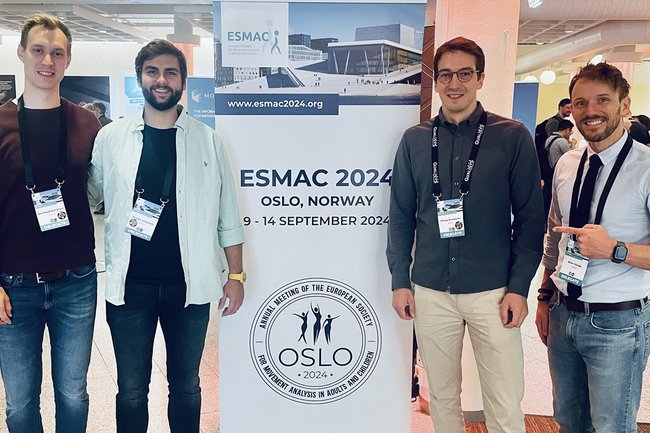Innovations in gait analysis
St. Pölten UAS strongly represented at this year's ESMAC
The European Society for Movement Analysis in Adults and Children (ESMAC) is one of the most important conferences in the field of clinical gait analysis in Europe. This year the ESMAC took place in Oslo.
St. Pölten UAS was represented with a total of eight contributions, including five presentations and three posters. The CDHSI, the IGW and the ICMT presented their interdisciplinary research in the field of gait analysis. The topics of the contributions ranged from machine learning and virtual reality to real-time sonification as biofeedback in therapy and the validation and testing of cost-effective gait analysis systems for clinical practice. In the future, the latter could enable gait analysis without expensive equipment and laboratories in therapeutic practice. Brian Horsak also organized a pre-conference seminar on “Machine Learning for Clinical Gait Analysis: A Quick Start Guide for Newcomers” together with Djordje Slijepčević from the ICMT.
A special highlight was the nomination of Philipp Krondorfer's paper for the Best Paper Award. The CDHSI already took third place last year. This year's nominated paper deals with the prediction of knee contact forces using machine learning. This could save costly and time-consuming manual calculations and simulations in clinical practice in the future.
Presentations
- Horsak, B., Prock, K., & Dumphart, B. (2024). Inter-session repeatability of a Smartphone-based 3D Markerless system to assess joint Kinematics for walking and a sit-to-stand task. Gait & Posture, 113, 95–96. https://doi.org/10.1016/j.gaitpost.2024.07.110
- Horsak, B., Puhr, M., Prock, K., Simonlehner, M., & Dumphart, B. (2024). To undress or not: Effects of clothing conditions on smartphone-based 3D markerless motion capture. Gait & Posture, 113, 96–97. https://doi.org/10.1016/j.gaitpost.2024.07.111
- Horst, F., Slijepcevic, D., Schöllhorn, W. I., Horsak, B., & Zeppelzauer, M. (2024). Explainable artificial intelligence for walking speed classification from vertical ground reaction forces. Gait & Posture, 113, 215–216. https://doi.org/10.1016/j.gaitpost.2024.07.232
- Krondorfer, P., Slijepčević, D., Unglaube, F., Kranzl, A., Zeppelzauer, M., Kainz, H., & Horsak, B. (2024). Predicting knee contact forces in walking: A comparative study of machine learning models including a physics-informed approach. Gait & Posture, 113, 125–126. https://doi.org/10.1016/j.gaitpost.2024.07.140 (Nominated for Best Paper Award)
- Slijepcevic, D., Krondorfer, P., Unglaube, F., Kranzl, A., Zeppelzauer, M., & Horsak, B. (2024). Predicting ground reaction forces in overground walking from gait kinematics using machine learning. Gait & Posture, 113, 214–215. https://doi.org/10.1016/j.gaitpost.2024.07.231

Copyright: St. Pölten UAS
Posters
- Simonlehner, M., de Jesus Oliveira, V. A., Prock, K., Iber, M., Horsak, B., & Siragy, T. (2024). Sonification can alter Joint Alignment for Personalized Rehabilitation: Evidence from a Controlled Pilot Study. Gait & Posture, 113, 212–213. https://doi.org/10.1016/j.gaitpost.2024.07.229
- Siragy, T., Russo, Y., & Horsak, B. (2024). Mediolateral margin of stability is larger in older than younger adults during the single-support phase. Gait & Posture, 113, 213–214. https://doi.org/10.1016/j.gaitpost.2024.07.230
- Eichwalder, J., Kaufmann, P., Mandl, T., Horsak, B., & Kainz, H. (2024). The effects of virtual reality on muscle synergies during walking and balancing in healthy adults. Gait & Posture, 113, 55–56. https://doi.org/10.1016/j.gaitpost.2024.07.068
Further Information and Links
- CDHSI (Center for Digital Health and Social Innovation)
- IGW (Institute of Health Sciences)
- ICMT (Institut für Creative\Media/Technologies)
- ESMAC (European Society for Movement analysis in Adults and Children)
